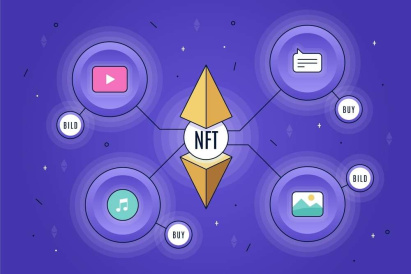Best NFT Marketplaces and How They Work

NFTs are Non-Fungible tokens, which mean a peculiar trade of tokens where one plus one doesn't equal two.
They are virtual copies of anything that can be owned by proxy.
Non-fungible tokens can mean any digital format of a painting, music, meme, documents, or in some weird cases, even receipts that can be tokenized and traded through the internet to the highest bidder.
To understand NFTs better, let's look at cryptocurrency first.
Cryptocurrency in Context to NFT
Cryptocurrencies are digital money. They are monitored and set up for consumption in their own set of rules that reject the rules for physical money. It's similar in that it's money, but that is where the similarities end. A cryptocurrency is governed by its rise and fall of trade in the marketplace. Bitcoin, Ethereum, Litecoin are a few of the cryptocurrencies in use, instead of thousands more down the line.
NFT tokens can be traded for liquid cash, and these tokens hold value, but the difference is that it doesn't quite work as a cryptocurrency with a set value, but it varies vastly for each token.
NFT Marketplace Concept
Now that we've looked at an overview of what NFT is let's look at the concept behind the market where you could buy and purchase the NFTs. NFT marketplace serves the purpose of acting as a digital vendor where the artists can auction, bid, bundle, sell their product of choice and where the traders purchase said products with cryptocurrency.
The marketplace hosts blockchain technology, which enables a direct transition between the two parties concerned and holds a digital trail of all the transactions made as a result. These features in the blockchain eliminate any need for intermediaries. They also account for a safe transaction of the product.
Blockchain in NFT
Blockchain is the idea of a ledger made online and public. Each transaction is made a note of and given a specific code set that becomes null and void when tampered with. That makes it nearly impossible to mess with the legitimacy and to meddle with in case of hackers or bugs. This same concept is also primarily used in cryptocurrencies and NFTs.
How NFT Marketplaces Work?
Some of the notable marketplaces dedicated for NFTs to take a note of are Rarible, Opensea, Axie Infinity, Mintable, etc. These are trusted, well-oiled machines that churn out thousands of tokens to be sold and brought on their platforms, and they give the creators freedom and the confidence to exercise their art in the said platform.
Marketplaces are standardized, meaning they follow a set of standard rules across all the multiple groups of marketplaces, for every creator, to level the playing field, and every aspect of the trade is global and open. Its transparency makes it the perfect place for no-nonsense trading, eliminating the risk of hacking and theft.
The marketplace is also interoperable. Since the trade is open, so is the marketplace and the product's availability across various forums. They all share the same non-fungible token standards (ERC 721 Token and ERC 1155 Token), which act as a communication channel between the different parties to update and apply a token sale under a particular domain be used across all the other marketplaces as sold.
The market is scalable, and the sky's the limit. Creators have the chance to bank upon every single project as a separate entity, also as a grouped-up bundle of multiple projects under the same project name.
There is always the issue and the fear with the creators about the duplication/recreation factor of their NFT art, and there is one also with the investors who purchase the NFTs at the sole promise of getting to own the purchase. Well, though there can be a plethora of replicas and recreation, your registered artwork is unique and one of a kind. No amount of forgery and naysayers could argue otherwise. And there are also AIs set in place to takedown any replications that pop up in competing marketplaces. If the tokens hold an emotional connection through owning it or have a monetary investment value to the investor, they are unique nonetheless.
The ranking and the bundle systems are set in place for the creators to monitor their art's value and popularity.
The selling sector of the NFTs consists of various methods of trading, including but not limited to bidding, auctions, fixed prices, etc... These are decided solely by the artist.
The Future of NFT Marketplaces
As advancements go, the NFT marketplace development has reached new heights since its inception and grows in folds.
NFTs seems to be the new trend of investments to the traders of the new world, and it's not going anywhere anytime soon. It is here to stay, and the definition of what entails a non-fungible token also changes with time.
The fact that NFTs have a crucial impact on the global economy makes it something to notice and grab the opportunity ASAP.
The possibilities to grow in the market are endless, and therein comes the chance to understand how to trade and make safe bets on the products you buy or sell.
Who Can Benefit From NFT Marketplace Development
Anyone interested in the new and current medium of trading and artists with a one-of-a-kind leash on their identity and art can benefit from the development in the world of the NFT marketplace. These places are a catalyst for the growth of the creators on an unimaginable scale where they could create instant revenue for their work without any of the drawbacks of setting up shop (physically); instead, they get royalties and passive income as a consequence. The traders also get their money's worth in ownership of a scarce item. This facet makes it an excellent avenue for buyers to get excited about future investments and trades.
Linda John








 Scroll to top
Scroll to top